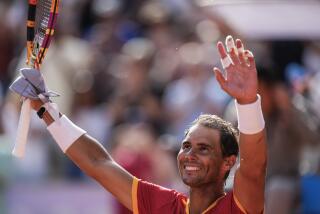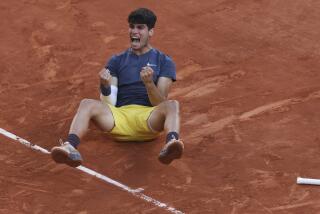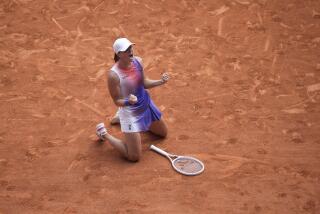Nadal will always have Paris, it seems
- Share via
PARIS — The revolution in France is over. The king is back on the throne of Roland Garros, a restoration that looked as majestic as it did inevitable.
Rafael Nadal shook off his shock defeat at the hands of Robin Soderling last year and beat him in Sunday’s final to win the French Open for the fifth time in six years. In a masterful performance on the red clay, the magician from Mallorca produced a dazzling array of shots that got him past one Swede and put him hard on the heels of another, Bjorn Borg, the only man to own more French titles.
It was a re-coronation that squeezed tears of joy from Nadal, who is on a remarkable comeback streak after months of dealing with injury and personal problems, including his parents’ separation.
He collapsed onto his back after converting his first match point, sobbed long and hard into his towel, then told the appreciative crowd how emotional it felt to be back on the winner’s podium to hoist the silver Musketeers Cup, which winked encouragingly at him in the sunlight.
“Last year was a difficult year, and I worked a lot to be here,” the 24-year-old Spaniard said afterward, the trophy close at hand. “This is very important for me. It was a personal goal to be back at my best.”
Not only did he save what he called his best performance of the tournament for the final match, but he won the championship -- his seventh Grand Slam title -- without the loss of a set over the entire two weeks, repeating a feat he achieved here in 2008.
The 6-4, 6-2, 6-4 victory over Soderling will propel Nadal back to the top of the world rankings, a position he surrendered to Roger Federer almost exactly one year ago.
There was no surrender anywhere on court Sunday, either from Nadal or from Soderling, who kept trying to find a chink in his opponent’s armor.
With his booming serve and lightning-fast groundstrokes, the rangy Swede was unafraid to take it to Nadal and ripped a number of winners from the back of the court into the corners and onto the sidelines.
But Nadal’s muscular athleticism, superior shot-making and an uncanny internal GPS that lets him know exactly where he is on court at every moment, from every angle, proved impossible to overcome, rescuing him whenever he was in danger.
He chased down every ball, sliding on Roland Garros’ distinctive terre battue, and often recovered from awkward positions to win a point through tenacity and willpower. The Spaniard never lost either his nerve or his serve despite facing eight break points, and exploited his opportunities when they arose.
“It was very difficult to play against Robin. . . . It’s almost impossible to have the control of the points against him,” Nadal said.
“I played with very good tactic, I think, and the movement was at my best level today.”
His tendinitis-prone knees never wobbled throughout the 2 hours 18 minutes he and Soderling spent on court.
For the Swede, the only man ever to beat Nadal at Roland Garros, defeat was tough, marking his second consecutive straight-sets loss in the final here. Last year, he was trounced by Federer.
“I think I can beat anybody, but when Rafa is playing like this, you need to have a really good day, which unfortunately I didn’t,” he said.
He had some chances, under conditions that might have been expected to favor him. Unlike the previous few days of sweltering heat, Sunday was windier and colder by several degrees, and the sun made only fitful appearances through a tarp of gray clouds that dumped plenty of rain in the morning but kept their peace through the afternoon.
Such conditions usually make the balls bounce lower and heavier, neutralizing some of Nadal’s phenomenal high-bouncing topspin.
But Soderling committed 45 unforced errors, 13 more than his total of winners.
“I didn’t play as good this year as I did against him last year. I didn’t serve as well. I wasn’t hitting the ball as clean,” Soderling said. “I didn’t really get into the match.”
In the second game of the second set, he earned four break points on Nadal’s serve, prompting chants of “Rob-een! Rob-een!” from the stands.
But the man some consider possibly the best clay-court player in history saved every one, running down Soderling’s shots from side to side, serving an ace and dinking a drop volley for a winner.
Throughout the match, Nadal was like an artist working with the rust-colored clay. He sculpted points with his looping forehands and chiseled a few low slices with his backhand to make his 6-foot-4 opponent bend low.
Serving in the final game, with the trophy directly in his line of sight on a pedestal at the other end of the court, Nadal raced to a 40-0 lead. When Soderling netted a forehand on the next point, the cup was his.
“I’m back,” said Nadal, who will probably be seeded No. 1 at Wimbledon later this month. “And I win.”
More to Read
Go beyond the scoreboard
Get the latest on L.A.'s teams in the daily Sports Report newsletter.
You may occasionally receive promotional content from the Los Angeles Times.











